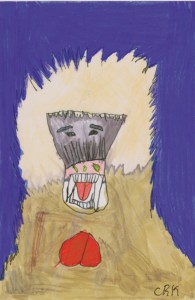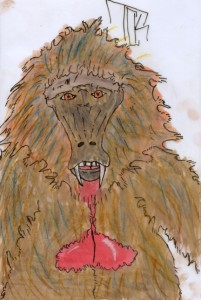Gelada Monkey (Theropithecus gelada)
High in the mountains of Ethiopia live large groups of monkeys, the geladas, who spend their days grazing on grass, mating, socializing, and making a variety of interesting sounds that some people speculate could reveal something about the evolution of human language and music. Also known as bleeding-heart baboons and lion baboons (although they aren’t actually baboons), the geladas are the only remaining grazing primate. (In Coco’s drawing, below, you can see a gelada with his upper lip drawn back, showing the grass he’s been eating.) They organize themselves in large troops that consist of “harem” groups as well as nonbreeding males. In the harem groups, each of which comprises a handful of females and a breeding male, the females are in charge of the family’s movements, and they decide when it’s time to trade in their male for a new one.
In most baboons and monkeys, swellings on the females’ rear ends indicate their reproductive ability. Because geladas spend so much time sitting on their rumps, though, this would be an impractical way for them to signal to potential mates. The red patches on their chests provide these swelling signs instead. In the female, the color and and size of the patch indicate where she is in her reproductive cycle; in the male, the patch shows his status.
Once, the geladas were targeted for their beautiful fur. Then came the Ethiopian civil war, which brought gunfire to their mountain home and made it impossible for scientists to study the monkeys. Now, they face their biggest threat ever: climate change. As the mountains where the monkeys live get warmer, scientists say, the geladas will almost certainly become extinct. Not only does the warmer climate threaten the grasses that the monkeys depend on for nutrition, it also means that humans will be able to farm at ever-higher altitudes, and where there are farms, there cannot be geladas. These strange and beautiful monkeys are in serious danger of becoming just one more victim of our neglect and apathy toward the planet. It’s too bad the other animals have to share Earth with us.




It’s great to have a new Daily Mammal. And now it’s a triple threat! Very nice drawings!!
Thanks, Dad! The kids won’t be drawing all the mammals,
Thanks, Dad! The kids won’t be drawing all the mammals, but I hope they’ll do at least some of them!
The cool thing about geladas that I always remember is that they are the most vocal primate (after us, I guess). Because grass is so lacking in nutrients, they have to spend all day grazing, and as they do this with their hands and heads down their options for communication are quite limited, so they chat to each other all day, apparently!